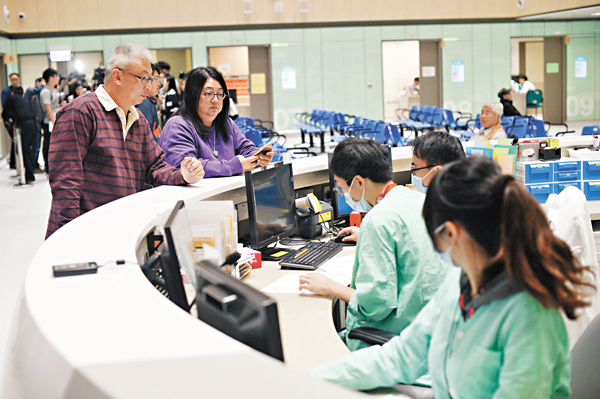 ■自願醫保計劃有助改善公私營醫療的失衡狀態。圖為上周啟用的天水圍醫院。 資料圖片
■自願醫保計劃有助改善公私營醫療的失衡狀態。圖為上周啟用的天水圍醫院。 資料圖片■Jeffrey Tse [ywc_jeffrey@hotmail.com]
原文
經過為期約兩年的公眾諮詢(public consultation)後,食物及衛生局於1月初公佈自願醫保(Voluntary Health Insurance Scheme)的諮詢報告。
該報告建議在2018年上半年推出有關計劃,市民購買合資格及有認證的醫療保險產品,可以申請退稅;但「高風險池」("high-risk pool")和「必定承保」("guaranteed acceptance")兩項重要內容將被抽起,為此業界人士和部分市民懷疑該計劃是否有足夠吸引力,能否產生應有成效。
吸引力低保費高 將難維持
香港醫療架構目前總體上運作良好,但公營醫療服務承受越來越沉重的壓力,許多低收入人士由於沒有能力負擔費用較高昂的私營醫療服務,只能在沒選擇的情況下長期輪候公營醫療服務,令公營醫院的服務長期嚴重供不應求,加上人口老化(ageing population)以及醫療成本上升,政府的公共醫療開支異常龐大。
2016/17年度醫療衛生的經常開支達570億元,佔政府經常開支16%。預計未來隨香港人口增長和老齡化加劇,這筆巨額開支將越滾越大。
因此,政府確有必要及早採取有效措施,改革(reform)醫療體制,改善公私營醫療服務的嚴重失衡(recalibrate the public-private balance)。而推出自願醫保,將有能力作出一定承擔的中等收入者,分流(diverted)到私營醫療體系。
由於政府強調醫保屬於自願性質,在推出這項措施時,就需要考慮到各方持份者(stakeholders)的需求和利益平衡點,但從目前情況看,僅是提供微不足道的退稅優惠的話,恐怕吸引力不夠,一旦參與的人不多,保險公司的保費(premiums)也必然難以下調,整個計劃就很難維持下去。
應討論注資 體現決心承擔
也有專家指出,政府在之前曾經提出過要為該計劃注資500億元,但此次好像又沒有了下文。雖然巨額注資會受到某些人士反對,認為是變相補貼了某個階層。
但客觀而言,中等收入階層(middle-income group)交稅多,又沒有享受到多少福利,在這些方面適當補貼一些,也不違背社會公平原則。
最重要的是,政府充分注資可以體現政府的決心(resolve)及承擔,讓該計劃能夠具有更多彈性(flexibility)。
政府有關方面在正式公佈方案時,應根據市民的疑惑給予全面解釋,與社會各界進行良好溝通,政府尤其應更多地體現公共財政的承擔(commitment),努力增加自願醫保的吸引力,否則將有可能沒有多少人積極響應。
(標題及小標題為編輯所加)
(摘錄自文匯報社評5-1-2017)
譯文
After almost two years of public consultation, the Food and Health Bureau released its report on the Voluntary Health Insurance Scheme (VHIS) in early January.
According to the report, the new scheme shall commence early next year, and citizens who purchased VHIS-compliant health insurance products could enjoy tax deductions. However, the 'high-risk pool" and "guaranteed acceptance" terms would also be dropped from the minimum requirements. Both the insurance sector and the community have voiced some concern over the attractiveness and effectiveness of the scheme.
Hong Kong's healthcare system is largely efficient for now, however the pressure on the public healthcare sector will continue to increase. As low-income groups cannot afford medical services offered by the private sector, they have no other options than to wait for public services.
Combined with the rapidly ageing population and escalating medical costs, the public healthcare system has been continuously overburdened while the expenditure for public health remains staggeringly enormous.
Plan hard to sustain on high premiums
During the 2016/17 fiscal year, the estimated recurrent expenditure for healthcare has been HK$ 57 billion, accounting for 16 per cent of recurrent government expenses. The amount is expected to increase as the population grows and ages. It is therefore necessary for the government to take early and effective measures to reform the healthcare system and to recalibrate the public-private balance.
With the introduction of the VHIS, demand from middle-income individuals could be diverted to the private sector.
As the government emphasises that the scheme is voluntary in nature, a balance has to be struck between the needs and interests of various stakeholders. Yet, the attractiveness of the current proposal is questionable as it only offers meagre tax concessions to buyers. If the scheme fails to attract the public, there would not be as much room to cut down premiums, thus compromising its sustainability.
Governmental investment shows resolve
Besides, the government also seems to have backed out from a plan to inject HK$ 50 billion into the VHIS, according to pundits. Some people might object to fuelling the scheme with huge sums of public money, as it would only benefit a fraction of the community.
Objectively speaking however, the middle-income group contributes most to the public coffers without enjoying much of our social benefits. It would still be fitting and socially just to subsidise the group in this regard. More importantly, the government could demonstrate its resolve while allowing more flexibility to the scheme by injecting sufficient funds.
When officially announcing full details of the scheme, the authorities should strive to clear the public's doubts and maintain effective communication with the society. The government should particularly step up its commitment to public finances and up the appeal of the VHIS, lest low popularity would render the scheme impracticable.
Exercise
1. 雙軌醫療制度
2. 經常開支
3. 稅項寬減
4. 醫療架構
5. 公私營協作
6. 保費
7. 公眾諮詢
8. 承保範圍
9. 人口老化
10. 可持續性
Answer
1. dual-track healthcare system
2. recurrent expenditure
3. tax concession
4. healthcare system
5. public-private partnership
6. premium
7. public consultation
8. coverage
9. population ageing
10. sustainability

